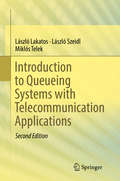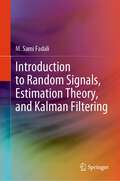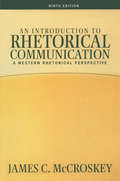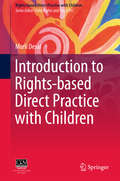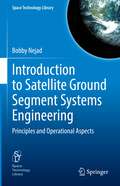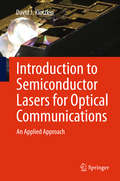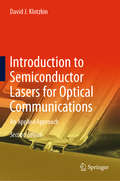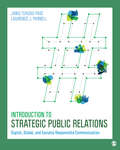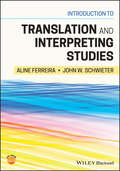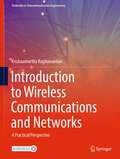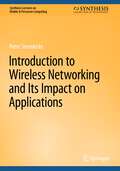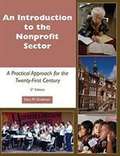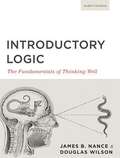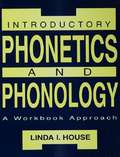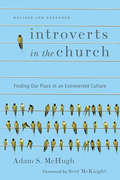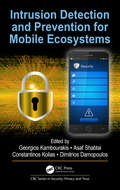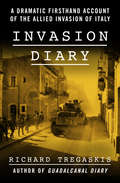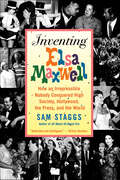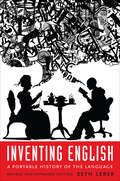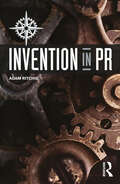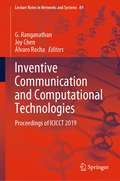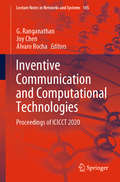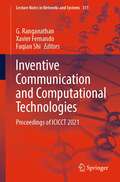- Table View
- List View
Introduction to Queueing Systems with Telecommunication Applications
by László Lakatos László Szeidl Miklós TelekThe book is the extended and revised version of the 1st edition and is composed of two main parts: mathematical background and queueing systems with applications. The mathematical background is a self-containing introduction to the stochastic processes of the later studied queueing systems. It starts with a quick introduction to probability theory and stochastic processes and continues with chapters on Markov chains and regenerative processes. More recent advances of queueing systems are based on phase type distributions, Markov arrival processes and quasy birth death processes, which are introduced in the last chapter of the first part.The second part is devoted to queueing models and their applications. After the introduction of the basic Markovian (from M/M/1 to M/M/1//N) and non-Markovian (M/G/1, G/M/1) queueing systems, a chapter presents the analysis of queues with phase type distributions, Markov arrival processes (from PH/M/1 to MAP/PH/1/K). The next chapter presents the classical queueing network results and the rest of this part is devoted to the application examples. There are queueing models for bandwidth charing with different traffic classes, slotted multiplexers, media access protocols like Aloha and IEEE 802.11b, priority systems and retrial systems.An appendix supplements the technical content with Laplace and z transformation rules, Bessel functions and a list of notations. The book contains examples and exercises throughout and could be used for graduate students in engineering, mathematics and sciences.Reviews of first edition:"The organization of the book is such that queueing models are viewed as special cases of more general stochastic processes, such as birth-death or semi-Markov processes. … this book is a valuable addition to the queuing literature and provides instructors with a viable alternative for a textbook to be used in a one- or two-semester course on queueing models, at the upper undergraduate or beginning graduate levels."Charles Knessl, SIAM Review, Vol. 56 (1), March, 2014
Introduction to Random Signals, Estimation Theory, and Kalman Filtering
by M. Sami FadaliThis book provides first-year graduate engineering students and practicing engineers with a solid introduction to random signals and estimation. It includes a statistical background that is often omitted in other textbooks but is essential for a clear understanding of estimators and their properties. The book emphasizes applicability rather than mathematical theory. It includes many examples and exercises to demonstrate and learn the theory that makes extensive use of MATLAB and its toolboxes. Although there are several excellent books on random signals and Kalman filtering, this book fulfills the need for a book that is suitable for a single-semester course that covers both random signals and Kalman filters and is used for a two-semester course for students that need remedial background. For students interested in more advanced studies in the area, the book provides a bridge between typical undergraduate engineering education and more advanced graduate-level courses.
Introduction to Rhetorical Communication
by James C MccroskeyAn Introduction to Rhetorical Communication offers a true integration of rhetorical theory and social science approaches to public communication. This highly successful text guides students through message planning and presentation in an easy step-by-step process. An Introduction to Rhetorical Communication provides students with a solid grounding in the rhetorical tradition and the basis for developing effective messages.
Introduction to Rights-based Direct Practice with Children
by Murli DesaiThe Sourcebook introduces the theoretical and ideological foundation and methodological basis of Rights-based Direct Practice with Children. It starts with the methodology of participatory group workshops to facilitate learning of the content. The content draws linkages among the foundation of life skills; psychosocial, sociological and critical theories of childhood; and child rights values, categories and principles; with the approaches, methods and skills of direct practice with children. The book takes examples from India but makes significant contribution to training and reference material for child rights teachers, trainers, facilitators and field workers, across the world, especially in the developing countries.
Introduction to Satellite Ground Segment Systems Engineering: Principles and Operational Aspects (Space Technology Library #41)
by Bobby NejadThe ground segment is the fundamental backbone of every satellite project, yet it is usually not visible to the public or the end user of a satellite service. Also the bulk of existing published space literature tends to focus on the satellite or its subsystems. This book tries to fill this gap and addresses systems engineering concepts applied to the design, development, qualification, and deployment of the ground control segment required to operate a single satellite, a constellation, or even a manned space vehicle. The domain of ground segment engineering has significantly evolved in recent years, mainly driven by major advances in the IT sector. Hardware virtualisation or the availability of on-demand cloud computing services are typical examples of new technologies that have changed fundamental architectural concepts previously standard in heritage ground segments. Furthermore, the stark increase of cyber attacks - today a major risk to almost all critical IT based infrastructure - has made a cyber threat resilient architecture to become one of the indispensable design requirements for ground segment engineers. The new mega constellations recently put into space deploying up to several hundred of flying objects have put very demanding needs on the ground segment for automated satellite operations. These topics and more are addressed in the book’s chapters, along with a detailed explanation of the most relevant components of a typical ground segment architecture. The basic functional requirements, design features, and the most important ground and space segment interfaces are addressed and explained in detail, supported by a wealth of figures for easier understanding. This book is kept at an introductory level, allowing newcomers to get familiar with this fairly complex subject matter. It is therefore suitable for graduate students, but can equally serve as a valuable source of information for already experienced space engineers who seek to gain a deeper understanding of the ground segment infrastructure and related systems engineering processes. It can also help project managers to better interact with their systems engineers, satellite developers to define their ground segment interfaces, and satellite operators to improve their flight and ground procedures. It is very well suited for everyone intending to start a career in satellite ground segment systems engineering.
Introduction to Semiconductor Lasers for Optical Communications
by David J. KlotzkinThis textbook provides a thorough and accessible treatment of semiconductor lasers from a design and engineering perspective. It includes both the physics of devices as well as the engineering, designing and testing of practical lasers. The material is presented clearly with many examples provided. Readers of the book will come to understand the finer aspects of the theory, design, fabrication and test of these devices and have an excellent background for further study of optoelectronics. This book also: Provides a multi-faceted approach to explaining the theories behind semiconductor lasers, utilizing mathematical examples, illustrations and written theoretical presentations Offers a balance of relevant optoelectronic topics, with specific attention given to distributed feedback lasers, growth techniques and waveguide cavity design Provides a summary of every chapter, worked examples, and problems for readers to solve Incorporates and explains recent breakthroughs in laser design
Introduction to Semiconductor Lasers for Optical Communications: An Applied Approach
by David J. KlotzkinThis updated, second edition textbook provides a thorough and accessible treatment of semiconductor lasers from a design and engineering perspective. It includes both the physics of devices as well as the engineering, designing and testing of practical lasers. The material is presented clearly with many examples provided. Readers of the book will come to understand the finer aspects of the theory, design, fabrication and test of these devices and have an excellent background for further study of optoelectronics.
Introduction to Strategic Public Relations: Digital, Global, and Socially Responsible Communication
by Janis Teruggi Page Lawrence J. ParnellHow can public relations play a more active role in the betterment of society? Introduction to Strategic Public Relations: Digital, Global, and Socially Responsible Communication prepares you for success in today’s fast-changing PR environment. Recognizing that developments in technology, business, and culture require a fresh approach, Janis T. Page and Lawrence Parnell have written a practical introductory text that aligns these shifts with the body of knowledge from which the discipline of public relations was built. Because the practice of public relations is rooted in credibility, the authors believe that you must become ethical and socially responsible communicators more concerned with building trust and respect with diverse communities than with creating throwaway content. The authors balance this approach with a focus on communication theory, history, process, and practice and on understanding how these apply to strategic public relations planning, as well as on learning how to create a believable and persuasive message. Key Features Chapter-opening Scenarios capture your attention by discussing current PR challenges—such as the Wells Fargo cross-selling, VW emissions cover-up, and P&G’s “Like a Girl” campaign—and thus frame the chapter content and encourage active reading. At the end of the chapter, you explore various aspects of socially responsible communication to “solve” the PR challenge. Socially Responsible Case Studies in each chapter illustrate the key responsibilities of a modern public relations professional such as media relations, crisis communications, employee communications, applied communications research, and corporate and government-specific communications. Each case features problem-solving questions to encourage critical thinking. Social Responsibility in Action boxes feature short, specific social responsibility cases—such as Universals’ #NoFoodWasted, Nespresso in South Sudan, and Merck’s collaboration with AIDS activists—to highlight best practices and effective tactics, showing the link between sound public relations strategy and meaningful social responsibility programs. Insight boxes spark classroom discussion on particularly important or unique topics in each chapter. Personality Profile boxes will inspire you with stories from PR veterans and rising stars such as the U.S. CEO of Burson-Marstellor, the Chief Communication Officer of the United Nations Foundation, and the Executive VP at HavasPR.
Introduction to Strategic Public Relations: Digital, Global, and Socially Responsible Communication
by Janis Teruggi Page Lawrence J. ParnellHow can public relations play a more active role in the betterment of society? Introduction to Strategic Public Relations: Digital, Global, and Socially Responsible Communication prepares you for success in today’s fast-changing PR environment. Recognizing that developments in technology, business, and culture require a fresh approach, Janis T. Page and Lawrence Parnell have written a practical introductory text that aligns these shifts with the body of knowledge from which the discipline of public relations was built. Because the practice of public relations is rooted in credibility, the authors believe that you must become ethical and socially responsible communicators more concerned with building trust and respect with diverse communities than with creating throwaway content. The authors balance this approach with a focus on communication theory, history, process, and practice and on understanding how these apply to strategic public relations planning, as well as on learning how to create a believable and persuasive message. Key Features Chapter-opening Scenarios capture your attention by discussing current PR challenges—such as the Wells Fargo cross-selling, VW emissions cover-up, and P&G’s “Like a Girl” campaign—and thus frame the chapter content and encourage active reading. At the end of the chapter, you explore various aspects of socially responsible communication to “solve” the PR challenge. Socially Responsible Case Studies in each chapter illustrate the key responsibilities of a modern public relations professional such as media relations, crisis communications, employee communications, applied communications research, and corporate and government-specific communications. Each case features problem-solving questions to encourage critical thinking. Social Responsibility in Action boxes feature short, specific social responsibility cases—such as Universals’ #NoFoodWasted, Nespresso in South Sudan, and Merck’s collaboration with AIDS activists—to highlight best practices and effective tactics, showing the link between sound public relations strategy and meaningful social responsibility programs. Insight boxes spark classroom discussion on particularly important or unique topics in each chapter. Personality Profile boxes will inspire you with stories from PR veterans and rising stars such as the U.S. CEO of Burson-Marstellor, the Chief Communication Officer of the United Nations Foundation, and the Executive VP at HavasPR.
Introduction to Translation and Interpreting Studies
by John W. Schwieter Aline FerreiraA unique and balanced combination of translation and interpreting studies, edited and written by leading voices in the fields In Introduction to Translation and Interpreting Studies, accomplished scholars Aline Ferreira and John W. Schwieter have brought together a detailed and comprehensive introductory-level textbook covering the essential aspects of translation and interpreting studies. Through chapters authored by leading voices in the field, this book covers topics of theoretical and conceptual relevance—such as the history of the development of the field and methods for understanding gender, society, and culture as aspects of the role of the interpreter—as well as critical topics in the application of theory to real world practice. Beginning with an authoritative treatment of the theoretical developments that have defined the field since the early 1970s, this textbook first describes the influential work of such figures as Jakobson, Holmes, and Toury, thus ensuring students develop a thorough understanding of the history and theoretical underpinnings of the fields of translation and interpreting studies. The text then begins to introduce grounded discussions of interpreting in specialized fields such as legal and healthcare interpreting and sign language translation. Learning is reinforced throughout the text through pedagogical features including reflection questions, highlighted key words, further readings, and chapter objectives. Instructors will also have access to companion website with PowerPoint slides and multiple-choice questions to support classroom application. Truly a unique work in translation and interpreting studies, this essential new textbook offers: A thorough introduction to the fields of translation and interpreting with discussion of applications to interdisciplinary topics Explorations of translation machines and technology, including their history and recent trends Practical discussions of culture, gender, and society in the context of translation and interpreting studies, as well as training and pedagogical issues in translation and interpreting A concise examination of translation process research and methods, including the mental processes and actions that people take while translating Complementary web materials including PowerPoint slides and practice questionsIdeal for advanced undergraduate and graduate students in programs in such as linguistics, language studies, and communications, or for those who plan to work in translation and/or interpreting, Introduction to Translation and Interpreting Studies will earn a place in the libraries of anyone interested in a reader-friendly translation and interpreting resource.
Introduction to Wireless Communications and Networks: A Practical Perspective (Textbooks in Telecommunication Engineering)
by Krishnamurthy RaghunandanThis book provides an intuitive and accessible introduction to the fundamentals of wireless communications and their tremendous impact on nearly every aspect of our lives. The author starts with basic information on physics and mathematics and then expands on it, helping readers understand fundamental concepts of RF systems and how they are designed. Covering diverse topics in wireless communication systems, including cellular and personal devices, satellite and space communication networks, telecommunication regulation, standardization and safety, the book combines theory and practice using problems from industry, and includes examples of day-to-day work in the field. It is divided into two parts – basic (fundamentals) and advanced (elected topics). Drawing on the author’s extensive training and industry experience in standards, public safety and regulations, the book includes information on what checks and balances are used by wireless engineers around the globe and address questions concerning safety, reliability and long-term operation. A full suite of classroom information is included.
Introduction to Wireless Networking and Its Impact on Applications (Synthesis Lectures on Mobile & Pervasive Computing)
by Peter SteenkisteThis book teaches readers how wireless networks work, why some of their properties impact wireless network performance at the application level, and what both network engineers and application developers can do to cope with these challenges. Internet users increasingly rely on wireless access links for diverse tasks such as web browsing, video conferencing, interactive games, and data sharing. Irrespective of how they access the Internet, they expect good performance and a high quality of experience. Unfortunately, wireless access networks are much more challenging to build than wired networks. In wired networks, signals used for communication are contained in a carefully engineered transmission medium. In contrast, wireless signals travel in our physical environment, where the presence of obstacles, interference, and mobility can affect communication. In addition, network performance can differ significantly across physical environments. As a result, the performance of wireless links is often lower and less predictable than that of wired links. The author structured the book according to the layers in the Internet protocol stack, similar to traditional network books. However, rather than presenting a general description of each layer, the focus is on wireless networks and how they differ from wired networks.
Introduction to the Nonprofit Sector: A Practical Approach for the Twenty-first Century
by Gary M. GrobmanThis is an introductory text on the nonprofit sector and nonprofit organizations. It provides an overview of the history, theory, and scope of the nonprofit sector. It discusses issues facing nonprofits, such as legal and regulatory issues, ethics, quality, fiscal, and liability issues. It also provides practical guidelines for writing mission and vision statements, strategic planning, hiring, firing, lobbying, communicating, using the Internet, and other functions of nonprofit organizations. Each chapter includes a synopsis at the beginning, as well as discussion questions, activities, and bibliographic references at the end. An index is included.
Introductory Logic:The Fundamentals of Thinking Well (5th Edition.)
by Douglas Wilson James B. NanceThis book intends to help students in establishing a concrete and applicable knowledge of propositional arguments.
Introductory Phonetics and Phonology: A Workbook Approach
by Linda I. HouseSuccess in mastering any language requires knowledge in speaking, reading, and writing the language. The speaking component requires the understanding and use of correct pronunciation, emphasis, and syntactic patterns. The written component requires mastery of the alphabet, spelling, and the ability to write, print, or type the pattern. Very early in the learning process, speakers of the English language become keenly aware of the language's lack of sound to symbol correspondence. To help speech/language researchers, media personnel, individuals learning English as a second language, and others interested in correct pronunciation, the International Phonetic Alphabet (IPA) was devised. Extensively class tested, this book offers a practical understanding approach to phonetics and the IPA in a workbook format. It will be welcomed by professionals, students, and trainees in the fields of communication science, communication disorders, speech pathology, and linguistics.
Introverts in the Church: Finding Our Place in an Extroverted Culture
by Adam S. McHughIntroverts in the Church
Intrusion Detection and Prevention for Mobile Ecosystems (Series in Security, Privacy and Trust)
by Georgios Kambourakis, Asaf Shabtai, Constantinos Kolias and Dimitrios DamopoulosThis book presents state-of-the-art contributions from both scientists and practitioners working in intrusion detection and prevention for mobile networks, services, and devices. It covers fundamental theory, techniques, applications, as well as practical experiences concerning intrusion detection and prevention for the mobile ecosystem. It also includes surveys, simulations, practical results and case studies.
Invasion Diary: A Dramatic Firsthand Account of the Allied Invasion of Italy
by Richard TregaskisA dramatic and richly detailed chronicle of the Allied invasions of Sicily and Italy from one of America&’s greatest war correspondents. Following the defeat of Axis forces in North Africa, Allied military strategists turned their attention to southern Italy. Winston Churchill famously described the region as the &“soft underbelly of Europe,&” and claimed that an invasion would pull German troops from the Eastern Front and help bring a swift end to the war. On July 10, 1943, American and British forces invaded Sicily. Operation Husky brought the island under Allied control and hastened the downfall of Benito Mussolini, but more than one hundred thousand German and Italian troops managed to escape across the Strait of Medina. The &“soft underbelly&” of mainland Italy became, in the words of US Fifth Army commander Lt. Gen. Mark Clark, &“a tough old gut.&” Less than a year after landing with the US Marines on Guadalcanal Island, journalist Richard Tregaskis joined the Allied forces in Sicily and Italy. Invasion Diary documents some of the fiercest fighting of World War II, from bombing runs over Rome to the defense of the Salerno beachhead against heavy artillery fire to the fall of Naples. In compelling and evocative prose, Tregaskis depicts the terror and excitement of life on the front lines and recounts his own harrowing brush with death when a chunk of German shrapnel pierced his helmet and shattered his skull. An invaluable eyewitness account of two of the most crucial campaigns of the Second World War and a stirring tribute to the soldiers, pilots, surgeons, nurses, and ambulance drivers whose skill and courage carried the Allies to victory, Invasion Diary is a classic of war reportage and &“required reading for all who want to know how armies fight&” (Library Journal). This ebook features an illustrated biography of Richard Tregaskis including rare images from the American Heritage Center at the University of Wyoming.
Inventing Arguments (Second Edition)
by John Mauk John MetzThe text's prominent focus on invention teaches students to recognize the rhetorical elements of any argumentative situation and apply the tools of argument effectively in their own writing.
Inventing Elsa Maxwell: How an Irrepressible Nobody Conquered High Society, Hollywood, the Press, and the World
by Sam StaggsInventing Elsa Maxwell, the first biography of this extraordinary woman, tells the witty story of a life lived out loud. With Inventing Elsa Maxwell, Sam Staggs has crafted a landmark biography. Elsa Maxwell (1881-1963) invented herself–not once, but repeatedly. Built like a bulldog, she ascended from the San Francisco middle class to the heights of society in New York, London, Paris, Venice, and Monte Carlo. Shunning boredom and predictability, Elsa established herself as party-giver extraordinaire in Europe with come-as-you-are parties, treasure hunts (e.g., retrieve a slipper from the foot of a singer at the Casino de Paris), and murder parties that drew the ire of the British parliament. She set New York a-twitter with her soirees at the Waldorf, her costume parties, and her headline-grabbing guest lists of the rich and royal, movie stars, society high and low, and those on the make all mixed together in let-'er-rip gaiety. All the while, Elsa dashed off newspaper columns, made films in Hollywood, wrote bestselling books, and turned up on TV talk shows. She hobnobbed with friends like Noel Coward and Cole Porter. Late in life, she fell in love with Maria Callas, who spurned her and broke Elsa's heart. Her feud with the Duchess of Windsor made headlines for three years in the 1950s. One of the twentieth century's most colorful characters is brought back to life in this biography by the author of All About All About Eve.
Inventing English: A Portable History of the Language
by Seth LererA history of English from the age of Beowulf to the rap of Eminem, &“written with real authority, enthusiasm and love for our unruly and exquisite language&” (The Washington Post). Many have written about the evolution of grammar, pronunciation, and vocabulary, but only Seth Lerer situates these developments within the larger history of English, America, and literature. This edition of his &“remarkable linguistic investigation&” (Booklist) features a new chapter on the influence of biblical translation and an epilogue on the relationship of English speech to writing. A unique blend of historical and personal narrative, both &“erudite and accessible&” (The Globe and Mail), Inventing English is the surprising tale of a language that is as dynamic as the people to whom it belongs. &“Lerer is not just a scholar; he's also a fan of English—his passion is evident on every page of this examination of how our language came to sound—and look—as it does and how words came to have their current meanings…the book percolates with creative energy and will please anyone intrigued by how our richly variegated language came to be.&”—Publishers Weekly (starred review)
Invention in PR
by Adam RitchieA handbook for pushing the limits of PR to inventing things, rather than only promoting them. When PR teams live or die on the success or failure of the products and services they support, Invention in PR shows how they can take a stronger hand in their creation. This book says the profession can do better than waiting for someone else to determine, develop and package what a company sells. It spurs PR pros to go beyond what they're handed and come up with new products and services that change a brand's life. Through tales of award-winning campaigns passionately told by their creator, readers learn how to apply invention at the beginning of the PR process and take away usable strategies and tactics. With PR under constant pressure to evolve, communications pioneer Adam Ritchie uncovers practitioners' aptitude for invention and empowers them to harness it. For PR professionals ready to rebel against taking a back seat to their counterparts in marketing and advertising, Invention in PR teaches them how to beat every other discipline to the punch by coming up with the product or service idea first. This guide will fire up professionals of all generations about what they can build. It will change the way experienced pros approach their jobs, and inspire students to break the rules in the best possible ways.
Inventive Communication and Computational Technologies: Proceedings of ICICCT 2019 (Lecture Notes in Networks and Systems #89)
by Álvaro Rocha Joy Chen G. RanganathanThis book gathers selected papers presented at the Inventive Communication and Computational Technologies conference (ICICCT 2019), held on 29–30 April 2019 at Gnanamani College of Technology, Tamil Nadu, India. The respective contributions highlight recent research efforts and advances in a new paradigm called ISMAC (IoT in Social, Mobile, Analytics and Cloud contexts). Topics covered include the Internet of Things, Social Networks, Mobile Communications, Big Data Analytics, Bio-inspired Computing and Cloud Computing. The book is chiefly intended for academics and practitioners working to resolve practical issues in this area.
Inventive Communication and Computational Technologies: Proceedings of ICICCT 2020 (Lecture Notes in Networks and Systems #145)
by Álvaro Rocha Joy Chen G. RanganathanThis book gathers selected papers presented at the 4th International Conference on Inventive Communication and Computational Technologies (ICICCT 2020), held on 28–29 May 2020 at Gnanamani College of Technology, Tamil Nadu, India. The respective contributions highlight recent research efforts and advances in a new paradigm called ISMAC (IoT in Social, Mobile, Analytics and Cloud contexts). The topics covered include the Internet of Things, Social Networks, Mobile Communications, Big Data Analytics, Bio-inspired Computing and Cloud Computing. Given its scope, the book is chiefly intended for academics and practitioners working to resolve practical issues in this area.
Inventive Communication and Computational Technologies: Proceedings of ICICCT 2021 (Lecture Notes in Networks and Systems #311)
by Xavier Fernando Fuqian Shi G. RanganathanThis book gathers selected papers presented at the Inventive Communication and Computational Technologies conference (ICICCT 2021), held on 25–26 June 2021 at Gnanamani College of Technology, Tamil Nadu, India. The book covers the topics such as Internet of things, social networks, mobile communications, big data analytics, bio-inspired computing, and cloud computing. The book is exclusively intended for academics and practitioners working to resolve practical issues in this area.
